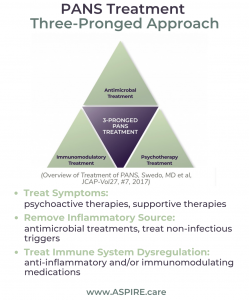
PANS Consensus Statement
Clinical Evaluation of Youth with Pediatric Acute-Onset Neuropsychiatric Syndrome (PANS): Recommendations from the 2013 PANS Consensus Conference Full Text and PDF Title: Clinical Evaluation...
PANS Consensus Statement on Diagnosing PANS and PANDAS –Clinical Evaluation of Youth with Pediatric Acute-Onset Neuropsychiatric Syndrome (PANS): Recommendations from the 2013 PANS Consensus Conference. Chang, MD et al (JCAP, Vol 25, No 1, 2015 Mary Ann Liebert, Inc.)
PANS PANDAS Symptoms PANS Consensus Statement
More on the PANS Diagnostic Process
The PANDAS Physicians Network (PPN) flowcharts for diagnosis and treatment will help clinicians evaluate their patients and determine the best course of treatment. Guidelines and workflows were approved by practitioners of the PANDAS Physicians Network Scientific Advisory Board. More detailed resources are available at www.pandasppn.org. Diagnosing and treating should be done by a licensed healthcare provider.
Primary care providers play important, ongoing roles in the diagnosis, treatment, and recovery of children with PANS/PANDAS. Children with a moderate or severe/life-threatening onset or a complex presentation may require treatment by an experienced multi-disciplinary team of specialists or a PANS/PANDAS specialist. Additional resources can be found at
PANS treatment utilizes three complementary modes of interventions to treat the patient completely. Three-pronged treatment protocols are dependent on disease trajectory, symptoms, and severity as well as lab work and patient history.

JCAP PANS Treatment Guidelines
The PANDAS Physicians Network (PPN) flowcharts for diagnosis and treatment will help clinicians evaluate their patients and determine the best course of treatment. The diagnostic flowchart and treatment guidelines include a detailed process provided for determining the appropriate diagnosis and symptom severity-based treatment protocols for mild, moderate, and severe/extreme cases.
Download PPN Treatment Flowchart
 PANS PANDAS Clinician Toolkit
PANS PANDAS Clinician ToolkitThere are invaluable resources to help clinicians learn how to recognize PANS PANDAS symptoms, do a workup to inform a possible diagnosis, and create a treatment plan. ASPIRE has assembled this one-page Clinician Toolkit but there are many resources throughout the website, and we are always adding more. So, check the website often.
 Diagnosis & Treatment of PANS PANDAS – Provider Packet
Diagnosis & Treatment of PANS PANDAS – Provider PacketClick the button below to download the twelve-page information packet Provider Information on PANS PANDAS, including Symptoms, Diagnosis, and Treatment.
 PANS PANDAS Guidelines for Children with Autism
PANS PANDAS Guidelines for Children with Autism
 Testing & Antibiotic Usage for GAS in PANS & PANDAS
Testing & Antibiotic Usage for GAS in PANS & PANDASASPIRE’S Professional Advisory Board Toolkit:
PANS is a clinical condition identified by an abrupt onset of a specific cluster of symptoms as a result of a variety of etiologies and disease mechanisms. Therefore, tracking symptoms, onset, severity, and duration is a critical part of making a clinical diagnosis and forming treatment plans. There are two useful PANS Symptom Rating Scale tools.

Developed by Tanya Murphy, MD and Gail Bernstein, MD. Source: PANS/PANDAS: CLINICAL & RESEARCH UPDATE, Gail A. Bernstein, M.D., 12/9/16, University of Minnesota
You can scroll through the pages of the Clinician Resources below. However, clicking on the link to the main Clinician Resources page is easier. Otherwise, you will be redirected to the top of this page each time you scroll to a secondary page in the resources.

Clinical Evaluation of Youth with Pediatric Acute-Onset Neuropsychiatric Syndrome (PANS): Recommendations from the 2013 PANS Consensus Conference Full Text and PDF Title: Clinical Evaluation...

PPN maintains industry standard guidelines for diagnostics and therapeutics, fosters continuous education and communication with the multidisciplinary medical community and sponsors research for...

Section on Behavioral Pediatrics (SBP) at the NIMH has information on PANS/PANDAS. Sue Swedo, MD, former Chief of the SBP at the NIMH, discovered that OCD, tics and other symptoms occurred after a...

The Stanford PANS Clinic was established in 2012 to build a comprehensive program with the goal of orchestrating groundbreaking research while providing tailored care for patients and families....

CPAE was founded in 2017 in collaboration with The University of Arizona and Banner-University Medicine in collaboration with the National Institute of Mental Health (NIMH). CPAE was the first center...
A number of universities have started multidisciplinary clinics since 2018. These centers are improving access to care and advancing high-quality research. Massachusetts General Hospita University of...